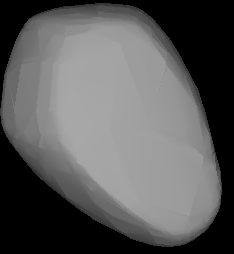201 Penelope
Penelope (minor planet designation: 201 Penelope) is a large main belt asteroid that was discovered by Austrian astronomer Johann Palisa on August 7, 1879, in Pola. The asteroid is named after Penelope, the wife of Odysseus in Homer's The Odyssey.
 A One-dimensional model of 201 Penelope based on its light curve. | |
| Discovery | |
|---|---|
| Discovered by | Johann Palisa |
| Discovery date | 7 August 1879 |
| Designations | |
| (201) Penelope | |
| Pronunciation | /pɪˈnɛləpiː/[1] |
Named after | Penelópē |
| A869 GA | |
| Main belt | |
| Adjectives | Penelopean /pɪˈnɛloʊˈpiːən/[1] |
| Orbital characteristics[2] | |
| Epoch 31 July 2016 (JD 2457600.5) | |
| Uncertainty parameter 0 | |
| Observation arc | 136.51 yr (49860 d) |
| Aphelion | 3.16233 AU (473.078 Gm) |
| Perihelion | 2.19242 AU (327.981 Gm) |
| 2.67737 AU (400.529 Gm) | |
| Eccentricity | 0.18113 |
| 4.38 yr (1600.2 d) | |
Average orbital speed | 18.19 km/s |
| 79.3202° | |
| 0° 13m 29.921s / day | |
| Inclination | 5.75820° |
| 157.026° | |
| 180.859° | |
| Physical characteristics | |
| Dimensions | 68.39±3.5 km[2] 87.72 km[3] |
| 3.7474 h (0.15614 d) | |
| 0.1604±0.018[2] 0.0881 ± 0.0187[3] | |
| M[3] (Tholen) | |
| 8.43,[2] 8.54[3] | |
Based upon the spectra of this object, it is classified as a M-type asteroid, indicating it may be metallic in composition.[3] It may be the remnant of the core of a larger, differentiated asteroid. Near infrared absorption features indicate the presence of variable amounts of low-iron, low-calcium orthopyroxenes on the surface. Trace amounts of water is detected with a mass fraction of about 0.13–0.15 wt%.[4] It has an estimated size of around 88 km.[3] With a rotation period of 3.74 hours, it is the fastest rotating asteroid larger than 50 km in diameter.[2]
References
- "Penelope". Oxford English Dictionary (3rd ed.). Oxford University Press. September 2005. (Subscription or UK public library membership required.)
- "JPL Small-Body Database Search Engine: diameter > 50 (km) and rot_per > 0 (h)". JPL Solar System Dynamics. Retrieved 12 May 2016.
- Pravec, P.; et al. (May 2012), "Absolute Magnitudes of Asteroids and a Revision of Asteroid Albedo Estimates from WISE Thermal Observations", Asteroids, Comets, Meteors 2012, Proceedings of the conference held May 16–20, 2012 in Niigata, Japan (1667), Bibcode:2012LPICo1667.6089P. See Table 4.
- Hardersen, Paul S.; Gaffey, Michael J.; Abell, Paul A. (January 1983), "Near-IR spectral evidence for the presence of iron-poor orthopyroxenes on the surfaces of six M-type asteroids", Icarus, 175 (1), pp. 141–158, Bibcode:2005Icar..175..141H, doi:10.1016/j.icarus.2004.10.017.
External links
- The Asteroid Orbital Elements Database
- Asteroid Lightcurve Parameters
- Asteroid Albedo Compilation
- 201 Penelope at AstDyS-2, Asteroids—Dynamic Site
- 201 Penelope at the JPL Small-Body Database
